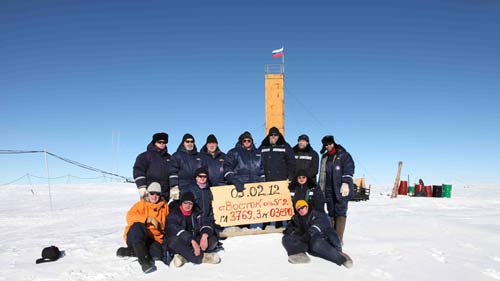Window Open to the Unknown World of Subglacial Lake Vostok

Above, the drillers' hero shot. The sign reads, "05.12.12, Vostok Station, Boreshaft 5G,
Lake at depth 3769.3 meters."
|
[This is a translation of the 8 February 2012 press release by the Antarctic and Antarctic Research Institute (AARI) in St. Petersburg. It describes the completion of the drilling process...] [8 February 2012] Today, the Arctic and Antarctic Research Institute has received the following official statement from the 57th RAE [Russian Antarctic Expedition] Vostok station chief Aleksander. M. Yelagin; and Nikolay I. Vasiliev, leader of the glaciological-drilling team: February 5 at 20.25 Moscow time at Russia's Vostok Station in inland Antarctica, the event occurred which had kept the international scientific community and many local and foreign mass media waiting in suspense for the last few months. The expert glaciological-drilling team of the 57th RAE was committed to penetrate the relict subglacial Lake Vostok water through deep ice borehole 5G. On the eve of February 4, at around 3766m depth, the drill made contact with a water lens. Evidence of this was the fact that the lower 70m of the recovered ice core appeared glazed, as if it had been immersed in water. However, no channels or capillaries in the body core were visually observed. It is this contact with the water lens in the well which had been mistakenly perceived by some media as actual penetration into the aqueous layer of the lake. On the subsequent descent of the drill to the bottom hole, the process of drilling into ice did not continue. Instead, the drill assembly, designed for pumping drilling fluid with cuttings from the ice cutter drill bit, passed into a water lens. As it turned out, when the drilling equipment was raised, it included about 30-40 liters of water, which froze in the process of recovery due to the constant -55ºC temperature of the glacier. The sample was "fresh frozen" water, which was collected in special sterile laboratory glassware. After this operation, drilling of the ice was continued, and at the level of 3769.3 m on the next day the drill made contact with an actual body of subglacial lake water. Sensors recorded a sharp increase in the bottomhole pressure, and the drill bit shell stopped rotating. Then, team leader Vasiliev and lead drilling engineer V. M. Zubkov, who at that time were on duty, quickly raised the drill shell assembly to the surface. Water in the lake rose up in the hole about 30-40m...as had been predicted in 2000 by researchers at the St. Petersburg State Mining University, and the Arctic and Antarctic Research Institute, who had developed the clean technology for penetration into the top of Lake Vostok. Less dense than lake water, drilling fluid, consisting of a mixture of kerosene and Freon, was forced rapidly up the borehole. As a result, about one and a half cubic meters [1500 liters] of drilling fluid poured from the top surface of the borehole into special trays installed in the drilling complex, and then it flowed back into the borehole. Thus, the results which were theoretically predicted 11 years ago have been fully proven in practice. A few hours before this outstanding event, the Minister of Natural Resources and Ecology, Yury Trutnev; and head of the Meterological service Rosgidromet, Alexander Frolov, had arrived at Vostok. On February 6th, the final Vostok flight for this summer season took place. The DC-3 BT 67 Turbo (Basler) aircraft took the glaciological-drilling team flew to the [Novo] Russian Antarctic station en route to the vessel "Akademik Fedorov." Project participants are scheduled to arrive in St. Petersburg from the port of Cape Town on a shuttle flight scheduled for February 24 this year. This achievement of Russian polar researchers and engineers has been a wonderful gift for the Day of Russian Science, which our country celebrates on 8 February. Head of the Russian Antarctic Expedition Vladimir Lukin In the photo: glaciological-drilling team at Vostok station of the 57th Russian Antarctic Expedition February 8, 2012 Press Service of the AARI |